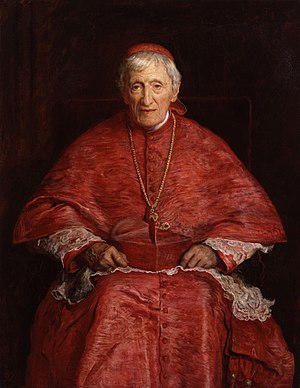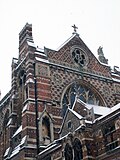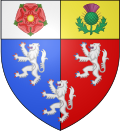Portal:University of Oxford
| Main page | Indices | Projects |
The University of Oxford portal
The University of Oxford is a collegiate research university in Oxford, England. There is evidence of teaching as early as 1096, making it the oldest university in the English-speaking world and the world's second-oldest university in continuous operation. It grew rapidly from 1167, when Henry II banned English students from attending the University of Paris. After disputes between students and Oxford townsfolk in 1209, some academics fled north-east to Cambridge where they established what became the University of Cambridge. The two English ancient universities share many common features and are jointly referred to as Oxbridge.
The University of Oxford is made up of thirty-nine semi-autonomous constituent colleges, four permanent private halls, and a range of academic departments which are organised into four divisions. Each college is a self-governing institution within the university, controlling its own membership and having its own internal structure and activities. All students are members of a college. It does not have a main campus, but its buildings and facilities are scattered throughout the city centre. Undergraduate teaching at Oxford consists of lectures, small-group tutorials at the colleges and halls, seminars, laboratory work and occasionally further tutorials provided by the central university faculties and departments. Postgraduate teaching is provided in a predominantly centralised fashion.
Oxford operates the Ashmolean Museum, the world's oldest university museum; Oxford University Press, the largest university press in the world; and the largest academic library system nationwide. In the fiscal year ending 31 July 2023, the university had a total consolidated income of £2.92 billion, of which £789 million was from research grants and contracts.
Oxford has educated a wide range of notable alumni, including 30 prime ministers of the United Kingdom and many heads of state and government around the world. 73 Nobel Prize laureates, 4 Fields Medalists, and 6 Turing Award winners have matriculated, worked, or held visiting fellowships at the University of Oxford, while its alumni have won 160 Olympic medals. Oxford is the home of numerous scholarships, including the Rhodes Scholarship, one of the oldest international graduate scholarship programmes. (Full article...)
Selected article
The Council of Keble College, Oxford ran the college (in conjunction with the Warden) from its foundation in 1868 until 1952. The council – a group of between nine and twelve men – has been described as "an external Council of ecclesiastical worthies", as most of the members came from outside the college, and many were not otherwise linked to the university. Keble was established by public subscription as a memorial to the clergyman John Keble. The first council members were drawn from the committee whose work had raised the money to build the college. By keeping matters relating to religion and the college's internal affairs in the hands of the council, the founders hoped to maintain Keble's religious position as "a bastion of 'orthodox' Anglican teaching" against the opponents of Tractarianism. In total, 54 men served on the Council, 11 of whom were college alumni; in 1903, Arthur Winnington-Ingram (Bishop of London) became the first former Keble student to join the council. It ceased to exist after 9 April 1952, when new statutes of the college placed full management in the hands of the Warden and Fellows. (Full article...)
Selected biography
Selected college or hall
Pembroke College was founded in 1624 and named after William Herbert, 3rd Earl of Pembroke, who was Chancellor of the University at the time. Pembroke's coat of arms contains the English rose and Scottish thistle to represent King James I, in whose reign the college was founded, and three lions rampant from the arms of the Earl of Pembroke. The college was established on the site of a university hostel for law students dating from the 15th century, called Broadgates Hall, with money provided by Thomas Tesdale (a merchant from Abingdon) and Richard Wightwick (a Berkshire clergyman). It is located just to the south of the city centre, opposite Christ Church. It has gradually expanded in size, with further buildings added in the 18th, 19th and 20th centuries. There are about 400 undergraduates and about 120 postgraduates. Alumni include the lexicographer Samuel Johnson (although he did not complete his degree because of lack of funds) and James Smithson (whose bequest founded the Smithsonian Institution in Washington, D.C.). J. R. R. Tolkien was a Fellow of Pembroke for twenty years, writing The Hobbit and the first two books of The Lord of the Rings during this time. Roger Bannister, the first man to run the mile in under four minutes, is a former Master of the college. (Full article...)
Selected image

Did you know
Articles from Wikipedia's "Did You Know" archives about the university and people associated with it:
- ... that Sir Douglas Dodds-Parker, a junior Foreign Office minister during the Suez Crisis in 1956, was sacked by new Prime Minister Harold Macmillan (pictured) in 1957 for his private opposition to the invasion of Egypt?
- ... that English headmistress Olive Willis founded Downe House School, where her chauffeur-architect-engineer slept in her bathroom?
- ... that Sir William Gregory was appointed Speaker of the House of Commons in 1679 after only a year in parliament?
- ... that Giles Clarke, chairman of the England and Wales Cricket Board, studied Arabic at the University of Damascus?
- ... that the Welsh Tractarian priest John David Jenkins, known as the "Rail men's Apostle", became President of the Amalgamated Society of Railway Servants?
Selected quotation
Selected panorama
On this day
Events for 10 June relating to the university, its colleges, academics and alumni. College affiliations are marked in brackets.
|
Births
|
Deaths
|
Wikimedia
The following Wikimedia Foundation sister projects provide more on this subject:
-
Commons
Free media repository -
Wikibooks
Free textbooks and manuals -
Wikidata
Free knowledge base -
Wikinews
Free-content news -
Wikiquote
Collection of quotations -
Wikisource
Free-content library -
Wikiversity
Free learning tools -
Wikivoyage
Free travel guide -
Wiktionary
Dictionary and thesaurus













